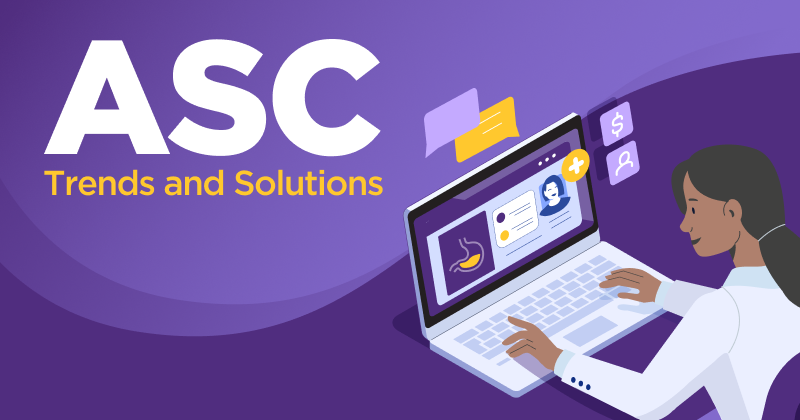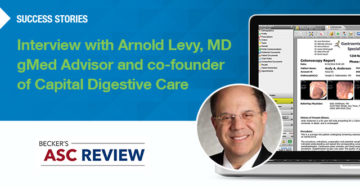Gastroenterology Trends: ASC Challenges and Solutions

Learn how to manage financial concerns while building a strong GI surgery center
To maintain a successful ambulatory surgery center (ASC), it can be helpful to stay on top of industry trends and opportunities. Recent challenges have put many ASC owners and operators in a tenuous position: Reimbursements may be declining, and without a higher staff count or new patients, it may be tough to gain the traction necessary for growth.
In this blog, we’ll take a look at the ASC landscape and go over solutions that can help your practice make the most of the challenges and opportunities ahead.
The Current ASC Outlook
A number of recent shifts currently impact how ASCs operate and make decisions.
Among them, the Centers for Medicare & Medicaid Services (CMS) has issued regulatory changes around what procedures can be done in hospitals or ASCs and how providers are reimbursed.
Inflation and supply chain disruptions may also make it harder than usual to access supplies without rising costs. If you’re leaning on cost control to help you maximize income, you need insight and agility to make procurement decisions that serve your business.
Additionally, patients may be taking on more financial responsibility and treating medical care like any other consumer decision. This could include searching online for price comparisons or reading reviews to learn more about ASCs and their reputations. Harnessing their interest takes marketing savvy and strategy.
Declining Reimbursements
A primary challenge facing ASCs is declining reimbursements. Recent changes, including reductions in Medicare and private payer rates, may impact the financial viability of an ASC. It may become increasingly difficult to cover operational costs, invest in advanced technologies, and attract skilled staff.
In these scenarios, every dollar counts. Use the tools at your disposal to support smooth billing and keep your schedule as full as you can.
To align with staff around the ways practice software can help, make sure everyone is following these best practices:
Code Decisions. Stay on top of correct coding. Software with suggested coding based on the providers’ documentation, along with your final review and coding decisions, may result in fewer inaccuracies. Automated claims scrubbers can help save time and limit errors, too.
Timely Billing. Finalize notes and charts the same day. This lets your billing teams move quickly, which may lead to your seeing revenue more quickly. It may also help mitigate the risk of missing charges, keeping your bills as accurate as possible.
Analytics. Review payment analytics. Use a wide variety of clinical and financial analytics as part of an all-in-one solution to help you manage your practice. See time to finalization, allowable versus received charges, denial rates and other insights.
Schedule Management. Limit no-shows with patient engagement. A hole in your schedule, even if it’s just for a prep appointment, can throw your whole week off and possibly impact your revenue. Send text message reminders and make it easy for patients to reschedule well in advance.
Payment Options. Offer multiple payment options, including payment plans, contactless payments and payment reminders.
Streamlining your operations can help you manage the impact of changes in reimbursements.
Managing Costs
Building cost efficiencies can be crucial to maintaining profit margins and reasonable patient costs. If your practice is working to identify cost control opportunities, an all in-one solution can help.
With an all-in-one solution built for ASCs, you can help streamline workflows, close process gaps and leverage additional services and resources, like revenue cycle management (RCM) and patient engagement. Connect your EHR and procedure documentation tools to integrate patient records and manage billing for office, endocenter, professional and facility charges on one platform.
By centralizing your ASC management, you can help limit hidden operational costs and costs associated with missing data or process gaps. You can also potentially reallocate staff to focus on tasks or care that brings greater value to your operations.
Staffing and Efficiency
ASCs aren’t the only ones experiencing staffing challenges, but the issue won’t solve itself. Unfortunately, with limited resources and increasing patient demands, low staff numbers may mean it’s even more difficult to manage costs and maintain productivity.
Automation can help relieve some of the burden your staff is likely experiencing.
For example, some of the tasks you can potentially automate include insurance eligibility verification and certain aspects of claims scrubbing. You can also integrate patient engagement tools, automating appointment reminders or deploying text to pay and other electronic payment methods.
This lets you reallocate staff efforts, extending capabilities and increasing efficiency, while lowering risk of burnout.
As your staff develops their proficiency in the software, your ASC may be able to realize meaningful productivity gains that mitigate challenges around hiring and retention.
Marketing and Patient Engagement
While it’s important to manage financial impacts and develop lean practices, a more straightforward solution is attracting and retaining more patients.
Attracting and retaining patients may require a targeted marketing strategy, but ASC marketing efforts, like search engine optimization and reputation management, can be valuable over time.
That’s because patients these days may be more likely to research facilities on their own. You may be able to earn their business by optimizing your website to appear at the top of search engine results and by having as many positive reviews as possible.
Ramp up your marketing and patient engagement by:
- Updating your website to highlight your unique value propositions or showcase price transparency.
- Developing and executing a reputation management strategy to earn reviews on major search engine result pages.
- Refreshing website pages and content for search engine optimization (SEO) and visibility in your geographies.
- Increasing your social media marketing efforts to connect on platforms where patients already interact with content.
- Launching paid advertising campaigns that scale based on your ASC’s range of offers and keywords.
- Instituting patient engagement tactics, like self-scheduling, appointment reminders and follow-up surveys.
Another marketing tip for ASCs: Being transparent with pricing and services can help differentiate your center from the competition, including hospitals — especially those that fail to meet CMS’ hospital price transparency rules.
For example, use pricing tools to generate an easy-to-read, itemized sheet that shows the patient’s estimated responsibility, copay and deductible, as calculated by your clearinghouse.
Sharing your commitment to price transparency on your website, social media channels and via paid advertising campaigns could make your ASC a top choice for new patients.
Continue to make it easy for them by breaking payments down over a certain time period and supporting their ability to pay in installments or through various channels. This type of business model could eventually earn you repeat patients who advocate for your ASC with social media comments or reviews, bringing your efforts full circle.
Meeting Today’s Challenges
In today’s healthcare climate, ASCs are challenged to do more with less, requiring center owners to lead with confidence in their decisions. ModMed can provide solutions to help you regain control of operational scenarios and work to improve revenue. For more on how ModMed ASC solutions can help keep your business competitive, book a demo.
This blog is intended for informational purposes only and does not constitute legal or medical advice. Please consult with your legal counsel and other qualified advisors to ensure compliance with applicable laws, regulations and standards.







